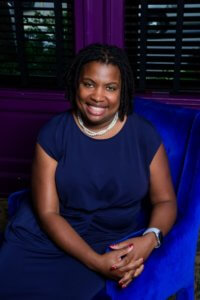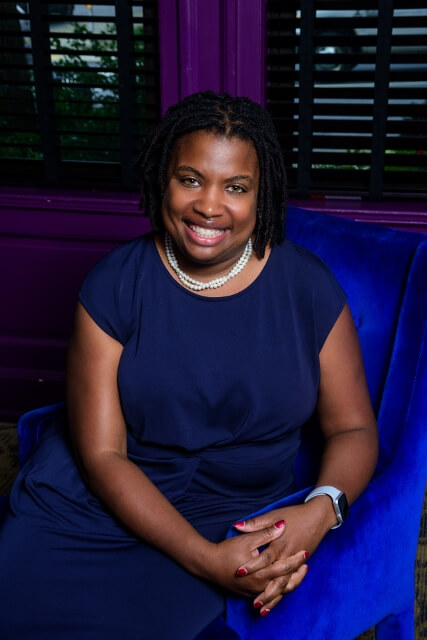An Interview with LaTida Smith, President & CEO, Moses Taylor Foundation
For more about the series, Black & Bold: Perspectives on Leadership, click here
LaTida Smith, President & CEO, Moses Taylor Foundation
Hopeful. Deliberate. Resilient.
LinkedIn
Tell me about your current role?
 I’m the second president of the Moses Taylor Foundation which was created from the sale of a hospital in Scranton, PA. When the hospital was sold in 2012, the president of the hospital became the first president of the foundation. She put the legal structure in place; there are many specifics to tend to when a nonprofit hospital transitions to a private foundation. When that work was complete, the board recruited someone to launch the philanthropy. I had spent the prior twelve years at a health conversion foundation in Cleveland and was ready for my next leadership opportunity. Around that time a recruiter reached out. I had never been to Scranton. However, this opportunity came at the right time. Starting a foundation from the ground up was intriguing.
I’m the second president of the Moses Taylor Foundation which was created from the sale of a hospital in Scranton, PA. When the hospital was sold in 2012, the president of the hospital became the first president of the foundation. She put the legal structure in place; there are many specifics to tend to when a nonprofit hospital transitions to a private foundation. When that work was complete, the board recruited someone to launch the philanthropy. I had spent the prior twelve years at a health conversion foundation in Cleveland and was ready for my next leadership opportunity. Around that time a recruiter reached out. I had never been to Scranton. However, this opportunity came at the right time. Starting a foundation from the ground up was intriguing.
I most enjoy setting the strategy for how to invest in improving the health of people in Northeast Pennsylvania. We have a blank slate and have taken time to determine where we can add the most value, how we can increase opportunities for people across our eleven-county region to live healthier lives. It’s a phenomenal privilege to have this responsibility.
I was born and raised in Cleveland and (from my background) really grew to understand health and the social determinants of health from an urban context. Northeast Pennsylvania is a community is marked by small cities but largely rural. In many ways (coming to Scranton) I had to suspend my assumptions about how health philanthropy should work and learn new ways of listening, learning and investing in communities. It has made me a much better philanthropy practitioner and required I ask many more questions and engage a much broader diversity of stakeholders to truly appreciate a community and its needs.
So, there’s been a shift in how you do the work?
It’s challenged me to think about how I use different resources in different ways. We do not have a local public health department here…no constellation of well-resourced nonprofits. Coming here I thought I would look for the same players I was used to working with and plug-and-play into the models that had worked for me in the past. I quickly learned trying to do a Cleveland thing in Scranton wouldn’t get me very far. I had to appreciate the different types of assets that exist here and let those assets determine my approach.
If there was a soundtrack of greatest hits related to your career, what would make the list?
I used to listen to music all the time on my way to work, but now it’s mostly cable news—which is probably not the most inspiring way to start a morning. When I do listen to music Beyoncé and India Arie are staples, but one song I return to frequently is “Stand” by Donnie McClurkin. My work can be all-consuming, and challenges can seem so much greater than my ability to impact them. Sometimes in arrogance I start to believe I’ve got to do it all myself or in fear I believe there’s nothing I can do. This song reminds me neither are true. It’s my job to do all that I can and then stand. God will see me through the rest. For me, philanthropy is a calling. This song is also a reminder of what God wants to do through me and my responsibility to play my part.
Work in the social sector can be very personal and linked to one’s values. Can you think of a time when your values were in tension and how you reconciled that tension or not?
The tension that I have experienced most often comes from often being at the intersection of diverse stakeholders who agree on where we need to go but hold competing views on how we get there, what it should take, etc. When I was at the Cleveland Health Department, I managed the AIDS program. The Mayor’s Office, City Council, nonprofit providers and community activists (many living with AIDS) would agree that they wanted to provide care for people but disagree fiercely on how to do the work or where to invest.
I used to think that my job in those situations – I’ve had many similar experiences in philanthropy – was to make everyone happy and reach that magical midpoint where everyone got a little bit of what they wanted. But as I matured and gained more experience, I realized that it’s not math. You can’t reach a midpoint most of the time. Making everyone happy was neither my job nor a durable outcome. And those conflicts, as tough as they are to maneuver, can be productive and appropriate given the gravity of what’s at stake. I learned that I could build trust by being honest and staying true to my word. My job was to listen deeply and take in the fullness of what each stakeholder was saying, where they were coming from, and make thoughtful decisions based on the fullness of that knowledge.
Can you share an experience in the workplace where you have had to reclaim your time? What was the context? How did you navigate it? What was the outcome?
The example that resonates most was my decision to move to Scranton. I had lived in Cleveland my whole life. My career and my family were rooted there. I had never imagined leaving. But I had outgrown my role. I knew it was my time to lead, but maybe Cleveland wasn’t the place. That was a very difficult decision. The opportunity in Scranton meant moving my family to a much less diverse community. I worried how it would impact me, my husband and our children. I also worried about how moving to smaller community would impact my career.
When I was trying to figure it out, I had the opportunity to speak with Dr. Yanique Redwood, CEO of Consumer Health Foundation. She told me about several other black women in philanthropy who had faced a similar choice and encouraged me to go where the opportunity was and trust that my leadership would carry me. I did. And the amazing thing for me is that since being here, I have had more opportunities to lead than I could have imagined. Two years ago, I had the opportunity to chair the board of Grantmakers for Effective Organizations during what became a pivotal moment in the organization’s history. A year ago, I joined the national board of Playworks. My team and I have had more opportunities to present our work in the past few years than I had in my previous decade in philanthropy. Yanique’s sage guidance was such a gift. I bet on myself. And I reclaimed my time.
What’s your approach to self-care? Are there any rituals you use to survive and thrive?
I aspire to be one of those women who wakes up, jogs and meditates. But I’m not there yet. My best friend and I talk on the phone during our evening commutes. We haven’t lived in the same city for ten years, but she keeps me lifted.
Settling into this CEO role, I have stopped compartmentalizing my life. Work matters to me and family matters to me. I take afternoons off to read to my kids’ classes. I have lots of weekday lunch dates with my husband and spend many Sunday afternoons reading grant proposals. Being fully present where I need to be, when I need to be, brings me a lot of peace and joy at this stage in my life.
We come from a resilient and strong lineage. How would you describe the type of ancestor you want to be and why?
I have been blessed to have women in my life who have nurtured my spirit. My Grandma Helen and her sister, my Great Aunt Maggie loved me deeply and believed with certainty that I was amazing. Being loved like that makes you soar and protects against the other things in life that can weigh you down. I want to be someone who can give that gift of love to others. The way I think about philanthropy is about holding that kind of unshakeable love and belief in the power of a community. I want to be the kind of ancestor who gave that kind of love to my family and community.
What advice would you offer other Black women trying to develop or amplify their voice and become self-advocates?
I have been fortunate to hold positions of power and influence for most of my career, but it took me a long time to appreciate my own power. I thought power looked a certain way. I knew it wasn’t necessarily male or white…but there were certain ways people in power acted or performed that never aligned with how I saw myself. Over time as I continued to hold positions of power, I discovered what was true and authentic for me, I let go any pretense of copying someone else, and I found my voice.
I keep a Maya Angelou quotation on my desk: “A woman in harmony with her spirit is like a river flowing. She goes where she will without pretense and arrives at her destination prepared to be herself and only herself.” It’s about the power of being yourself. For me it took maturity to get back to that point. I knew it when I was very young but got tripped up in the middle when I received evidence that suggested I needed to perform some other way to be successful. Now I’m coming back to confidence in being me.
If you could change the social sector in a way that would benefit, lift up, or affirm Black women, what would that change be?
I would put more Black women in positions of power. Period. Even though I believe you can lead from a variety of positions, it matters who is in power. When we are in leadership roles, at the board table or elsewhere, the conversation shifts and the sector changes. We hold space for one another and our communities in ways that are transformative. That is the one and most powerful thing that I would do.



Comment section